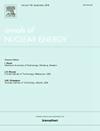Benchmarking a point reactor kinetics method with delayed neutron precursors transport using data from molten salt reactor experiment
IF 1.9
3区 工程技术
Q1 NUCLEAR SCIENCE & TECHNOLOGY
引用次数: 0
Abstract
A consistent point reactor kinetics (PRK) model-based method was developed for analyzing the transient behavior of circulating fuel systems such as molten salt reactors (MSRs). The consistent PRK model was derived based on the factorization approach and was exclusively used for calculating neutron flux amplitude, while the delayed neutron precursors were treated as part of the thermal-hydraulics model to better count for the spatial effects of species transport phenomena occurring in the circulating fuel systems. The mathematical models developed in the method was implemented using COMSOL Multiphysics platform featuring neutronics, thermal-fluidics, and species transport. An efficient reactivity feedback model is established within the platform to provide thermal feedback from the system-level thermal-hydraulics model to the PRK based neutronics model. The results produced by the computational models were validated against Molten Salt Reactor Experiment (MSRE) experimental data.
The developed models were first employed to examine MSRE responses at steady-state conditions, and then benchmarked with a couple of transient tests that took place during the MSRE 233U phase of operations: the reactivity insertion tests and the low power natural circulation test. In steady-state conditions, a parametric study examined the effects of flow rates on kinetics parameters and showed that delayed neutron fractions strongly correlated with flow rate, while prompt neutron generation time exhibited minor sensitivity. In reactivity insertion tests, different parameter sets were analyzed to assess the impact on reactor response, showing graphite temperature feedback has limited influence whereas fuel temperature feedback provides more impact. Additionally, the reactivity insertion rate has effect on power responses, especially at higher power levels. Also, the effect of circulating void fraction was addressed as a random process. In natural circulation test, the MSRE response to a stepwise increase of the heat rejection rate was tested. The flow in the primary loop was maintained by fuel density variations and the reactor power was controlled by the heat load through thermal feedback mechanisms. This transient is used to validate the heat transfer correlation and natural flow capabilities. All the results highlight the efficiency and accuracy of the developed consistent PRK method, validating its use in MSR-type advanced reactor safety analysis and design optimization.
为分析熔盐反应堆(MSR)等循环燃料系统的瞬态行为,开发了一种基于一致点反应堆动力学(PRK)模型的方法。一致的 PRK 模型是根据因式分解方法推导出来的,专门用于计算中子通量振幅,而延迟中子前体则作为热-水力学模型的一部分来处理,以便更好地计算循环燃料系统中发生的物种迁移现象的空间效应。该方法中开发的数学模型是通过 COMSOL Multiphysics 平台实现的,该平台具有中子、热流体和物种输运功能。在该平台内建立了一个高效的反应反馈模型,以提供从系统级热流体模型到基于 PRK 的中子模型的热反馈。计算模型得出的结果与熔盐反应堆实验(MSRE)的实验数据进行了验证。开发的模型首先用于检查 MSRE 在稳态条件下的响应,然后以 MSRE 233U 运行阶段进行的几次瞬态试验为基准:反应性插入试验和低功率自然循环试验。在稳态条件下,参数研究考察了流速对动力学参数的影响,结果表明延迟中子分数与流速密切相关,而快速中子生成时间的敏感性较低。在反应插入试验中,对不同的参数集进行了分析,以评估对反应堆响应的影响,结果表明石墨温度反馈的影响有限,而燃料温度反馈的影响更大。此外,反应性插入率对功率响应也有影响,尤其是在较高功率水平时。此外,还将循环空隙率的影响作为一个随机过程进行了研究。在自然循环测试中,测试了 MSRE 对逐步提高排热速率的响应。一环路中的流量由燃料密度变化来维持,反应堆功率则由热负荷通过热反馈机制来控制。该瞬态用于验证传热相关性和自然流能力。所有结果都凸显了所开发的一致 PRK 方法的效率和准确性,验证了其在 MSR 型先进反应堆安全分析和设计优化中的应用。
本文章由计算机程序翻译,如有差异,请以英文原文为准。
求助全文
约1分钟内获得全文
求助全文
来源期刊

Annals of Nuclear Energy
工程技术-核科学技术
CiteScore
4.30
自引率
21.10%
发文量
632
审稿时长
7.3 months
期刊介绍:
Annals of Nuclear Energy provides an international medium for the communication of original research, ideas and developments in all areas of the field of nuclear energy science and technology. Its scope embraces nuclear fuel reserves, fuel cycles and cost, materials, processing, system and component technology (fission only), design and optimization, direct conversion of nuclear energy sources, environmental control, reactor physics, heat transfer and fluid dynamics, structural analysis, fuel management, future developments, nuclear fuel and safety, nuclear aerosol, neutron physics, computer technology (both software and hardware), risk assessment, radioactive waste disposal and reactor thermal hydraulics. Papers submitted to Annals need to demonstrate a clear link to nuclear power generation/nuclear engineering. Papers which deal with pure nuclear physics, pure health physics, imaging, or attenuation and shielding properties of concretes and various geological materials are not within the scope of the journal. Also, papers that deal with policy or economics are not within the scope of the journal.
 求助内容:
求助内容: 应助结果提醒方式:
应助结果提醒方式:


